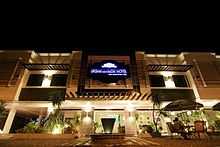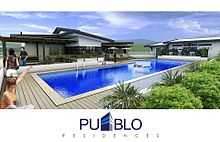Pueblo de Panay
| Headquarters | Roxas City, Capiz, Panay Island, Philippines |
|---|---|
| Website | www.pueblodepanay.com |
Pueblo de Panay is the first mixed-use, master-planned, and Filipino-inspired township development in Northern Panay. At 400 hectares, it is one of the largest contiguous developments among the regional cities in the Philippines.
Integrated in this development is a commercial business district complemented by eco-tourism areas, a Special Economic Zone, residential areas, and educational, institutional, and recreational facilities.
Location
Pueblo de Panay is located in the Seafood Capital of the Philippines, Roxas City, Capiz – a province in Panay Island. The township spans the areas of Lawaan, Dinginan, and Sibaguan, connecting two of only three major highways in the city. Pueblo de Panay has eight access points along these two highways, and is considered the gateway to the city of Roxas, as the Roxas City Integrated Transport Terminal is located in the township. Its nearest point is less than two kilometers aerial distance from the old town center (Pueblo de Capiz), where the old Spanish church, the Capiz Provincial Capitol, the Roxas City Hall, and other important city landmarks are located.
The opening of the new Roxas City Integrated Transport Terminal within Pueblo de Panay means that arriving passengers of public transportation vehicles like buses, jeepneys, and vans are connected to the jeepneys, taxis, and tricycles that travel to downtown Roxas City, whose nearest point is only two kilometers from the township. The township also has its own customized jeepneys, the PdP Libot vehicles, conveying passengers to different areas within Pueblo de Panay.
Roxas City is set midway between Iloilo and Boracay, two of the top tourist destinations in the country. Iloilo City (jump-off point to Guimaras Island) is 2.5 hours by road from Roxas City, while Caticlan, the entry point to Boracay, is a 3.5-hour drive away. New emerging tourist destinations nearby are Olotayan Island, an island barangay in Roxas City, and the Gigantes Islands and Sicogon Island of Iloilo, whose jump-off points in Northern Iloilo towns are reachable by a 1.5-hour drive from Roxas City.
History
Pueblo de Panay is named after Pan-ay,a historic town in Capiz located 20 minutes away from the heart of Roxas City.
The town of Pan-ay was the second Spanish settlement in the Philippines, replacing Cebu as the seat of Miguel Lopez de Legazpi’s colonial headquarters in the country.[1] Legend has it that Legazpi and his men, in search of food, exclaimed upon discovering the island, "Pan hay en estaisla!" (There is bread on this island!). So they established their first settlement in the island at the mouth of the Banica River in Capiz and called it Pan-ay.[2]
Pan-ay is the site of the famous coral-stone Sta. Monica Church, home to the largest Catholic Church bell in Asia. The bell was made from 70 sacks of gold and silver coins donated by the townsfolk. Measuring seven feet in diameter, five feet in height and weighing 10,400 kilograms or just over 10 metric tons, the Pan-ay bell is popular among tourists visiting Capiz.
- An inscription on the bell reads:
- “Soy la voz de Diosquellevare y ensalzaredesde el principio hasta el fin de este Pueblo de Panay para que los fieles de Jesus vengan a esta casa de Dios a recibirlas gracias celestials.”
- Translated to English, this means:
- “I am God’s voice which I shall echo and praise from one end to the other of the town of Panay, so that the faithful followers of Christ may come to this house of God to receive the heavenly graces.”[3]
In an homage to its province’s deep-rooted history and culture, Pueblo de Panay adopts the “Pueblo” or small Spanish town concept of development wherein the center of governance, education, religion, commerce, culture, recreation and other important community activities are integrated in a central “plaza” or park.
Background and Proponents
Pueblo de Panay is owned and developed by Pueblo de Panay, Inc. and master-planned by Blue Chip Builders, Inc. - both under the SHJPHI Group of Companies. SHJPHI (Sacred Heart of Jesus Prime Holdings Inc.) is a real estate and development company that has thus far provided more than 8,000 lots and/or housing units to the people of Roxas City and Capiz. Its projects include Twin Hearts Village, St. Francis Park, Mission Hills, Villa de San Lorenzo Ruiz, Happy Homes, Vista del Rio, Rio Grande, Costa Verde, Verdant Meadows, Centro Villas, Villa Peraz, Community Mortgage Program (CMP) Projects with the National Housing Authority, and Gawad Kalinga Projects with the Couples for Christ.
Pueblo de Panay started development in 2011. As of 2014, it is the site of various residential, commercial, educational, and government establishments. The proponents envision Pueblo de Panay as an eco-tourism business district which would have various investors as locators while promoting ecotourism activities in Roxas City and the rest of the province of Capiz.[4]
Investors and Locators
Commercial
- El Circulo Convention Center is located at one of the highest points in Pueblo de Panay, with a 360-degree view of the Roxas City’s coasts and hills. It has three function rooms that can accommodate up to 450 guests, and a garden reception area. Equipped with modern facilities, it is a place for celebrating occasions such as weddings, birthdays, family reunions, and other social gatherings. Part of the convention center building is occupied by Café Terraza, a restaurant/café serving various dishes and desserts.


- Hotel Veronica is a boutique hotel where each room is uniquely-designed. On the ground floor of the same building are restaurants and cafes: Festa Resto, Café Pueblo, and Ramboys Restaurant. Urban Manor Hotel is another hotel located in Pueblo de Panay. Its rooms feature modern interior design, and is located at Sacred Heart of Jesus Avenue, near the entry/exit point of Pueblo de Panay to the Lawaan Highway.


- Robinsons Place Roxas is a two-level full service mall, housing over 160 outlets for shopping, dining, services, and amusement. It is the largest mall in the Northern Panay region, with a total land area of 74,000 square meters.[5] The mall’s parking lot has over 800 car slots and 200 motorcycle slots. Robinsons Place Roxas is anchored by Robinsons retail giants Robinsons Department Store, Robinsons Supermarket, Robinsons Appliances, Handyman, and Daiso Japan. Inside is a Robinsons Bank, an amusement center, a food court serving regional and international cuisine, and four digital cinemas including a 3D cinema. The Lingkod Pinoy Center on the second floor also houses government agencies such as GSIS, PhilHealth, Pag-IBIG Fund, SSS, PHLPost and TESDA. [6]
- Punta Dulog, the first mixed-use commercial complex inside Pueblo de Panay, opened in July of 2014. Located beside the Roxas City Integrated Transport Terminal, it houses restaurants and cafes, convenience and drug stores, clothing and footwear shops, entertainment and service centers, and the new NBI Satellite Office. One section will be open to the public 24/7 by 2015, making it the first round-the-clock commercial establishment in Roxas City.
Residential
- Residential projects within Pueblo de Panay include SITIO UNO by Pueblo Residences, a mixed-use, modern-Filipino inspired midrise condominium development that is the first of its kind to be built in Roxas City. The groundbreaking was held on February 15, 2014 at its site near Robinsons Place Roxas and Pangpang Suba - a dining, entertainment, and recreational esplanade development. There will be commercial units for lease in the 1st to 2nd floors of SITIO UNO, and residential units for sale on the 3rd to 5th floors, including several loft units. The building plan also features a swimming pool, multiple elevators, basement parking, back-up power, and 24-hour security service. It is projected to be completed by 2016.

- Two subdivisions currently being developed in Pueblo de Panay are Verdant Meadows and Orchard Lane. Verdant Meadows is designed with a combination of Filipino and Spanish influences, and is accessible via Pueblo de Panay's Sacred Heart of Jesus Avenue, connected to both the Lawaan and Cagay-Ivisan Highways. Orchard Lane is also Filipino-Hispanic-inspired, a 12-hectare residential area with the amenities of a typical gated community.
Pueblo de Panay TechnoPark
- Pueblo de Panay is working with the Philippine Economic Zone Authority (PEZA) and the Tourism Infrastructure and Enterprise Zone Authority (TEZA) to provide incentives for Business Process Outsourcing (BPO) companies and tourism and export locators/investors. Pueblo de Panay TechnoPark, which will house investing BPO companies, has secured PEZA board approval as a Special Economic Zone (SEZ), only awaiting the government’s formal proclamation by 2015.[7]
Pueblo de Panay Educational Zone
- CHILD'S Academy is an elementary school in Pueblo de Panay specializing in the progressive type of education. This “hands-on” approach to learning focuses on making learning “fun” by engaging schoolchildren in various activities aside from the usual classroom lecture environment.
- The University of the Philippines Visayas is currently holding Master of Management – Business Management classes for professionals at the El Circulo Convention Center every Saturday for 6 trimesters, in a span of two years.[8] The current batch is expected to finish the course by June or July of 2016.
Panay Cold Chain Services Corp. (PCCSC)
- Panay Cold Chain Services Corporation is a partnership between Pueblo de Panay Inc. (PdPI) and Glacier Refrigerated Services Corporation (GRSC) for the construction and operation of a world-class Cold Storage Facility. GRSC is a leading Metro Manila-based company with a proven track record in cold storage and logistics chain operations, having received recognitions from the National Meat Inspection Services for the years 2007, 2008 and 2009.
Government Offices and Structures
- The Roxas City Integrated Transport Terminal is located in Pueblo de Panay, connecting public utility vehicles within the city to other municipalities, cities, and provinces in the Philippines. The 2-hectare facility in Pueblo de Panay primarily aims to decongest vehicular traffic around the city, and houses stores, food stalls, and other facilities.[9]
Biodiversity
Pueblo de Panay is an emerging ecotourism landmark that hopes to combine the amenities of a progressive city and the charm of a small provincial town. To retain and enhance the natural ecosystem within the township, only about half of the area will be developed into commercial uses and eco-tourism attractions. The rest will be landscaped open areas with plains, rivers, hills, and valleys preserved in their natural state.
References
- ↑ http://www.jstor.org/discover/10.2307/29791142?uid=2&uid=4&sid=21104500378903
- ↑ http://nlpdl.nlp.gov.ph:9000/rpc/cat/finders/CC01/NLP00VM052mcd/v1/v12.pdf
- ↑ http://historicphilippines.com/historic-churches-ii/st-monica-the-big-bell-panay-capiz/
- ↑ http://www.philstar.com/business/2013/04/28/935666/new-eco-tourism-project-rise-roxas-city
- ↑ http://www.interaksyon.com/lifestyle/robinsons-opens-biggest-shopping-mall-in-capiz
- ↑ http://www.robinsonsmalls.com/malls_roxas.php
- ↑ http://www.philstar.com/business/2013/04/28/935666/new-eco-tourism-project-rise-roxas-city
- ↑ http://mycapiz.com/index2.php?option=com_content&do_pdf=1&id=677
- ↑ http://panaynewsphilippines.com/2014/06/16/roxas-integrated-terminal-opens/